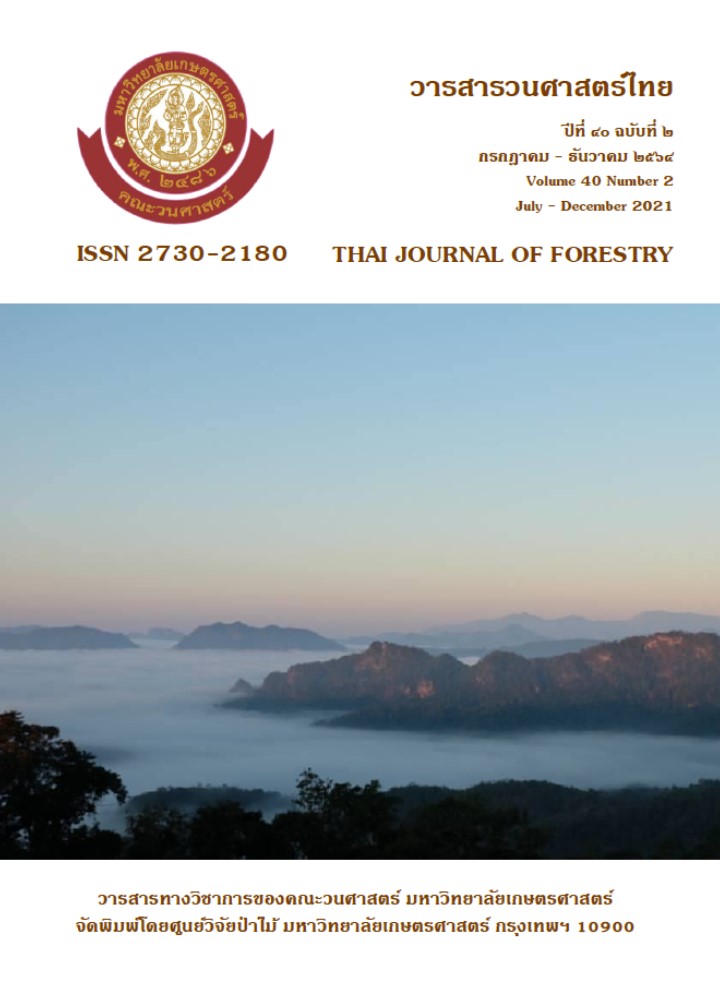การประยุกต์ใช้ภาพถ่ายจากอากาศยานไร้คนขับในการประเมินสุขภาพของป่าแสม บริเวณอ่าวไทยตอนบน
Main Article Content
บทคัดย่อ
การศึกษาลักษณะทางสุขภาพต้นไม้โดยทั่วไปทำได้ด้วยการประเมินอาการทางสายตาหรือวัดค่า Chlorophyll Fluorescence การขาดตัวบ่งชี้ลักษณะทางสุขภาพต้นไม้ที่นำไปใช้ได้และน่าเชื่อถือ ทำให้เกิดข้อจำกัดในการประเมินสุขภาพต้นไม้ป่าชายเลน การศึกษาครั้งนี้ ติดตามการฟื้นตัวเรือนยอดไม้แสม (Avicennia spp.) หลังจากการระบาดของหนอนแมลงกินใบในเดือนธันวาคม พ.ศ. 2560 โดยสำรวจภาพถ่ายทางอากาศด้วยอากาศยานไร้คนขับ วัตถุประสงค์เพื่อศึกษาตัวชี้วัดที่เป็นไปได้ในการบ่งชี้ลักษณะทางสุขภาพต้นไม้ป่าชายเลนจากการประเมินภาคพื้นดิน
วิธีการโดยสำรวจทางอากาศในพื้นที่ศึกษา จำนวน 2 ครั้ง ในเดือนมกราคม พ.ศ. 2561 และเมษายน
พ.ศ. 2562 สำรวจลักษณะทางสุขภาพของต้นไม้ภาคพื้นดิน สังเกตอาการที่ปรากฎบาดแผลบริเวณลำต้น เชื้อราปรากฎเป็นดอกเห็ด และร่องรอยหนอนเจาะ เก็บข้อมูลภาคพื้นดินภายในแปลงตัวอย่างขนาด 20 × 20 ม.2
ใช้ภาพถ่ายทางอากาศเพื่อคำนวณช่องว่างระหว่างเรือนยอด และใช้วิธี Ordinary Least Squares เพื่อหาความสัมพันธ์ของการปรากฎปัญหาทางสุขภาพกับการฟื้นตัวของช่องว่างระหว่างเรือนยอด
ผลการศึกษาพบว่าเรือนยอดของไม้แสมสามารถฟื้นตัวอย่างรวดเร็วหลังจากถูกแมลงทำลาย ชี้ให้เห็นว่าไม้แสมมีความความยืดหยุ่นสูงต่อการระบาด อย่างไรก็ตาม ในการประเมินสุขภาพของต้นไม้ป่าชายเลนอาจใช้ลักษณะของลำต้นที่พบบาดแผลเป็นตัวบ่งชี้ได้ เนื่องจากการปรากฏอาการสัมพันธ์กับการฟื้นตัวของเรือนยอดอย่างมีนัยสำคัญ สรุปได้ว่า สุขภาพต้นไม้ป่าชายเลนไม่สามารถประเมินด้วยสายตาจากภาคพื้นดินเพียงอย่างเดียว ควรมีการสำรวจทางอากาศที่ได้ภาพความละเอียดสูง จึงสามารถให้ดัชนีชี้วัดที่มีความน่าเชื่อถือ
Downloads
Article Details

อนุญาตภายใต้เงื่อนไข Creative Commons Attribution-NonCommercial-NoDerivatives 4.0 International License.
ข้าพเจ้าและผู้เขียนร่วม (ถ้ามี) ขอรับรองว่า ต้นฉบับที่เสนอมานี้ยังไม่เคยได้รับการตีพิมพ์และไม่ได้อยู่ในระหว่างกระบวนการพิจารณาตีพิมพ์ลงในวารสารหรือสิ่งตีพิมพ์อื่นใด ข้าพเจ้าและผู้เขียนร่วม (ถ้ามี) ยอมรับหลักเกณฑ์และเงื่อนไขการพิจารณาต้นฉบับ ทั้งยินยอมให้กองบรรณาธิการมีสิทธิ์พิจารณาและตรวจแก้ต้นฉบับได้ตามที่เห็นสมควร พร้อมนี้ขอมอบลิขสิทธิ์ผลงานที่ได้รับการตีพิมพ์ให้แก่วารสารวนศาสตร์ คณะวนศาสตร์ มหาวิทยาลัยเกษตรศาสตร์ กรณีมีการฟ้องร้องเรื่องการละเมิดลิขสิทธิ์เกี่ยวกับภาพ กราฟ ข้อความส่วนใดส่วนหนึ่ง หรือ ข้อคิดเห็นที่ปรากฏในผลงาน ให้เป็นความรับผิดชอบของข้าพเจ้าและผู้เขียนร่วม (ถ้ามี) แต่เพียงฝ่ายเดียว และหากข้าพเจ้าและผู้เขียนร่วม (ถ้ามี) ประสงค์ถอนบทความในระหว่างกระบวนการพิจารณาของทางวารสาร ข้าพเจ้าและผู้เขียนร่วม (ถ้ามี) ยินดีรับผิดชอบค่าใช้จ่ายทั้งหมดที่เกิดขึ้นในกระบวนการพิจารณาบทความนั้น”
เอกสารอ้างอิง
Arun, P.R. and M. Mahajan. 2012. Ecological costs and benefits of teak defoliator (Hyblaea puera Cramer) outbreaks in a mangrove ecosystem. Mar. Sci. 2: 48–51.
Biswas, O., B. Panja, P.Kr. Garain., S.Kr. Shah, B.Kr. Modak. and B. Mitra. 2017. Hyblaea puera (Cramer, 1777) [Lepidoptera : Hyblaeidae] infestation on Avicennia alba Blume in Sunder ban Biosphere Reserve, West Bengal, India. Proc. Zool. Soc. 71: 331–335.
Eslami-Andergol, L., P.E.R. Dale, J.M. Knight. and H. McCallum. 2015. Approaching tipping points: A focused review of indicators and relevance to managing intertidal ecosystems. Wetlands Ecol. Manage. 23: 791–802.
Fernandes, M.E.B., A.A.M. Nascimento. and M.L. Carvalho. 2009. Effects of herbivory by Hyblaea puera (Hyblaeidae: Lepidoptera) on litter production in the mangrove on the coast of Brazilian Amazonia. J. Trop. Ecol. 25: 337–339.
Lewis, R.R., E.C. Milbrandt, B. Brown, K.W. Krauss, A.S. Rovai, J.W. Beever. and L.L. Flynn. 2016. Stress in mangrove forests: Early detection and preemptive rehabilitation are essential for future successful worldwide mangrove forest management. Mar. Pollut. Bull. 109: 764–771.
Lewis, M. and R. Pryor. 2013. Toxicities of oils, dispersants and dispersed oils to algae and aquatic plants: Review and
database value to resource sustainability. Environ. Pollut. 180: 345–367.
Lewis, M., R. Pryor and L. Wilking. 2011. Fate and effects of anthropogenic chemicals in mangrove ecosystems:
A review. Environ. Pollut. 159: 2328–2346.
Lovelock, C.E., D.R. Cahoon, D.A. Friess, G.R. Guntenspergen, K.W. Krauss, R. Reef, K. Rogers, M.L. aunders, F. Sidik, A. Swales, N. Saintilan, L.X. Thuyen. and T. Triet. 2015. The vulnerability of Indo-Pacific mangrove forests to sea-level rise. Nature 526: 559–563.
Mehlig, U. and M. Menezes. 2005. Mass defoliation of the mangrove tree Avicennia germinans by the moth Hyblaea puera (Lepidoptera:
Hyblaeidae) in Equatorial Brazil. Ecotropica 11: 87–88.
Piyakarnchana, T. 1981. Severe defoliation of Avicennia alba Bl. by Larvae of Cleora injectaria Walker. J. Sci. Soc. Thailand. 7: 33–36.
R Core Team. 2020. R: A Language and Environment for Statistical Computing. Vienna, Austria.
Tran, L.X. and A. Fischer. 2017. Spatiotemporal changes and fragmentation of mangroves and its effects on fish diversity in Ca Mau province (Vietnam). J. Coast. Conserv. 21: 355–368.
Yim, M.W. and N.F.Y. Tam. 1999. Effects of wastewater-borne heavy metals on mangrove plants and soil microbial activities. Mar. Pollut. Bull. 39: 179–186.


